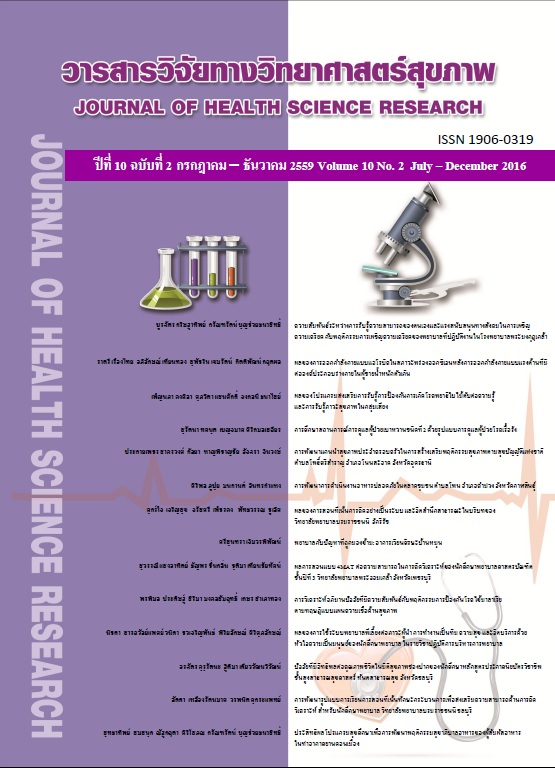ผลของการออกกำลังกายแบบแอโรบิคในสภาวะพร่องออกซิเจนหลังการออกกำลังกายแบบแรงต้านที่มีต่อองค์ประกอบร่างกายในผู้ชายน้ำหนักตัวเกิน
Main Article Content
บทคัดย่อ
การวิจัยเชิงกึ่งทดลองครั้งนี้มีวัตถุประสงค์เพื่อศึกษาผลของการออกกำลังกายแบบแอโรบิคในสภาวะพร่องออกซิเจนและสภาวะปกติหลังการฝึกแรงต้าน 2 วัน/สัปดาห์ ระยะเวลา 12 สัปดาห์ ที่มีต่อองค์ประกอบร่างกายในผู้ชายน้ำหนักตัวเกิน
กลุ่มตัวอย่างเป็นอาสาสมัครเพศชายที่มีน้ำหนักตัวเกิน จำนวน 20 คน จากคณะวิทยาศาสตร์การกีฬา มหาวิทยาลัยเกษตรศาสตร์ แบ่งเป็นกลุ่มทดลอง (10 คน) และกลุ่มควบคุม (10 คน) ทั้ง 2 กลุ่มทำการออกกำลังกายแบบ แรงต้าน หลังจากนั้นออกกำลังกายแบบแอโรบิค 20 นาที (65% ของอัตราการเต้นหัวใจสำรอง) โดยกลุ่มทดลองออกกำลังกายแบบแอโรบิคในสภาวะพร่องออกซิเจน (O2 = 16.30%) ส่วนกลุ่มควบคุมออกกำลังกายแบบแอโรบิคในสภาวะปกติ (O2 = 21.00%) ใช้เวลา 2 วัน เพื่อทำการทดสอบค่าร้อยละไขมันในร่างกาย อัตราการเผาผลาญพลังงานขณะพัก ความแข็งแรงสูงสุดในท่า Machine vertical chest press และ Smith machine half squats ก่อนการทดลอง หลังการทดลองสัปดาห์ที่ 4, 8 และ 12 และทดสอบความสามารถในการใช้ออกซิเจนสูงสุดก่อนการทดลองและหลังการทดลองสัปดาห์ที่ 12
ผลการวิจัยไม่พบความแตกต่างระหว่างกลุ่มของทุกตัวแปรหลังการทดลองสัปดาห์ที่ 4, 8 และ 12 แต่พบว่าทั้ง 2 กลุ่ม มีผลการทดสอบทุกตัวแปรหลังการทดลองสัปดาห์ที่ 12 ดีขึ้นกว่าก่อนการทดลอง (p < .05) โดยหลังการทดลองสัปดาห์ที่ 8 กลุ่มทดลองมีแนวโน้มค่าร้อยละไขมันในร่างกายลดลงและค่าร้อยละมวลกล้ามเนื้อเพิ่มขึ้นมากกว่ากลุ่มควบคุม
การออกกำลังกายแบบแอโรบิคในสภาวะพร่องออกซิเจนหลังการออกกำลังกายแบบแรงต้านเป็นทางเลือกสำหรับ ผู้ที่มีน้ำหนักตัวเกินในการลดไขมัน เพิ่มความแข็งแรง และมวลกล้ามเนื้อ
This quasi-experimental study investigated the effects of aerobic exercise in hypoxia and normoxia after resistance exercise two days per week over a 12 - week period on body composition in overweight males.
Twenty overweight college males from the Faculty of Sports Science, Kasetsart University, volunteered for the study. They were equally divided into treatment group (TG) and control group (CG). Both groups performed resistance training, followed by 20 minutes of aerobic exercise conditions: (65% of heart rate reserve); TG performed treadmill running in hypoxia (inspired O2 fraction = 16.30%) and the CG performed treadmill running in normoxia (inspired O2 fraction ~ 21.00%). Before start of the study and after 4, 8 and 12 weeks, all subjects completed 2 days of testing to determine body composition, strength (1 repetition maximum of Machine vertical chest press and Smith machine half squats) and VO2max test.
Results showed that there were no significant differences between the TG and the CG at 4, 8 and 12 weeks regarding body mass, body mass index, fat, muscle mass, basal metabolic rate, muscular strength and VO2max. Compared with pretest, the 12-week training programs of both groups produced significant (p < .05) improvements in all variables. After week 8, the TG was more inclined to reduce fat mass and increase muscle mass compared to CG.
Aerobic exercise under hypoxic conditions after resistance training is an alternative for overweight males to reduce fat mass, increase muscle mass and muscle strength.
Downloads
Article Details
บทความที่ได้รับการตีพิมพ์เป็นลิขสิทธิ์ของวิทยาลัยพยาบาลบรมราชชนนี จังหวัดนนทบุรี
ข้อความที่ปรากฏในบทความแต่ละเรื่องในวารสารวิชาการเล่มนี้เป็นความคิดเห็นส่วนตัวของผู้เขียนแต่ละท่านไม่เกี่ยวข้องกับวิทยาลัยพยาบาลบรมราชชนนี จังหวัดนนทบุรี และคณาจารย์ท่านอื่น ในวิทยาลัยฯ แต่อย่างใด ความรับผิดชอบองค์ประกอบทั้งหมดของบทความแต่ละเรื่องเป็นของผู้เขียนแต่ละท่าน หากมีความผิดพลาดใด ๆ ผู้เขียนแต่ละท่านจะรับผิดชอบบทความของตนเองแต่ผู้เดียว


